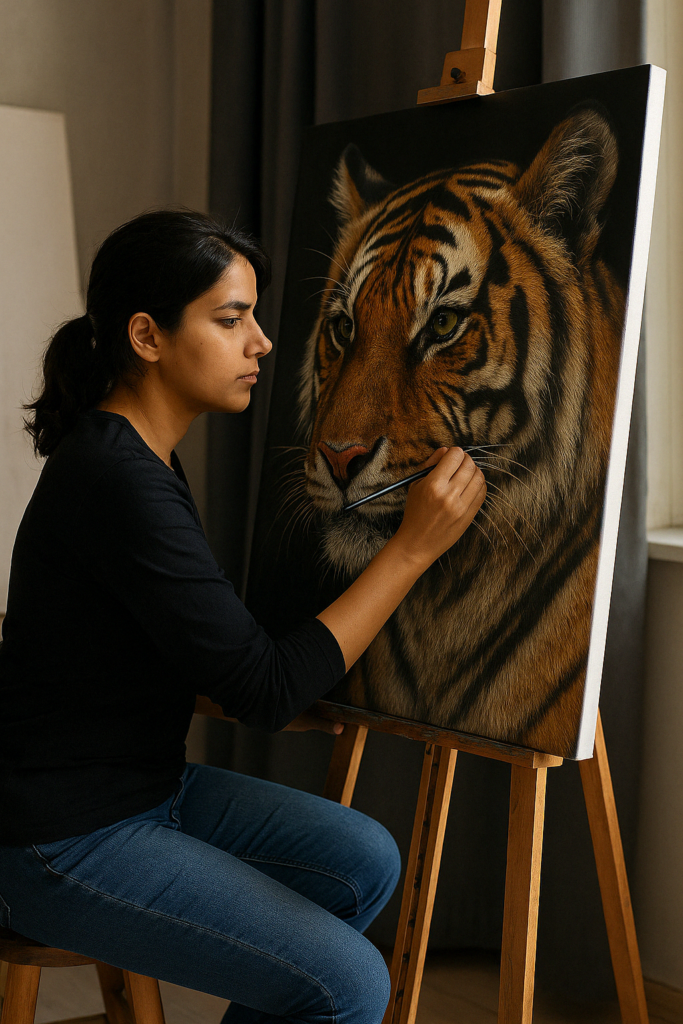Deeksha Chauhan, a 29-year-old self-taught wildlife artist, is using her hyper-realistic paintings to raise awareness and support for animal welfare. Her art doesn’t just showcase wildlife — it tells powerful stories that encourage empathy and demand attention toward conservation.
Her journey reflects a conscious decision to use art not just as creative expression, but as a vehicle for change.
Early Signs of Artistic Passion
Deeksha’s relationship with art began in childhood. Her mother, who introduced her to music and dance, played a key role in shaping her creative side. Despite these varied interests, it was painting that consistently drew her in.
Even during school, she would sketch on the back pages of notebooks. Over time, it became clear that art was her true calling — even if not everyone around her saw it that way.
Engineering Degree, but Art Never Left
Under family expectations, Deeksha pursued an engineering degree from Vidya College, Meerut, completing it in 2016.
She entered the corporate world and explored roles in HR, sales, and business analysis. However, none of them satisfied her. Most jobs lasted only a few weeks before she felt the need to leave.
She also explored academic fields like chemistry and neuroscience, and enrolled in a Python course — but again, her heart wasn’t in it.
“Whatever I did felt mechanical. Art was the only thing I returned to naturally,” she says.
Self-Study Became Her Foundation
In 2019, Deeksha took full control of her future. Tired of exam-focused courses, she started learning art on her own.
She followed international artists like Nick Sider and closely studied techniques in realism and hyper-realism.
Through observation, trial, and error, she built her own learning path. Her focus was simple: master the details and evoke emotion through precision.
Personal Loss Sparked a Deeper Purpose
Deeksha’s choice to focus on wildlife art was shaped by personal tragedy. She lost her pet dog in her arms — an experience that left her feeling powerless.
Videos of animal cruelty further disturbed her, prompting deep reflection.
“What am I doing to stop this?” she asked herself.
Instead of waiting for others to act, she used her art to create change. She began selling paintings and donating part of the proceeds to animal welfare efforts.
Wildlife Art in India: A New, Growing Space
Wildlife art is still a niche in India, but Deeksha has carved her space using social media.
She built her presence on Instagram and Facebook, attracting buyers from across India and abroad. Her clients are drawn to the almost photographic quality of her paintings.
“Many people think my work is AI-generated — but everything is hand-painted,” she says.
Signature Works and Global Reach
Some of Deeksha’s notable creations include:
- A five-by-three feet tiger painting, which took three months to complete
- A 3D hyper-realistic rhinoceros painting (30×40 inches) that went viral on Facebook
To date, she has sold over 50 paintings, with buyers in the US, Canada, and Europe. Most orders come from abroad, as India’s market for wildlife art is still developing.
Her work ranges from Rs 5,000 for a small 12×12 inch piece to Rs 1.2 lakh for larger, intricate works. In four years, she has earned around Rs 4 lakh.
Minimalist Living, Maximum Impact
Deeksha lives simply. Most of her earnings are reinvested in art materials and animal welfare.
She travels solo and often stays with locals instead of booking hotels. In return, she teaches village children about wildlife and the importance of respecting nature.
“Wherever I go, I carry my art supplies and continue painting,” she says.
Nature itself is her teacher — she studies it closely to incorporate minute details into her paintings.
Art, Education, and Empathy
For Deeksha, art is not just for galleries. She wants to use it for:
- Educational outreach
- Empathy-building among children
- Fundraising for wildlife organisations
- Spreading awareness of species under threat
Her mission includes teaching kids how to appreciate and protect nature. She believes the younger generation can play a critical role in conservation if guided properly.
“They need to unlearn old myths and understand how every species matters.”


